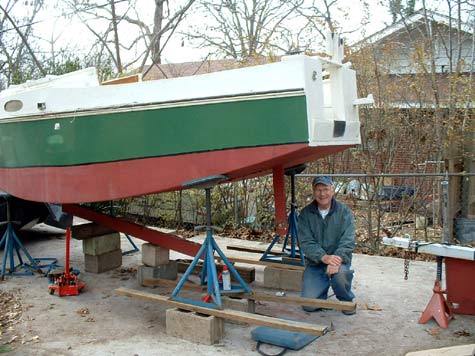Micro Maintenance and Shearwater Sail
by George Fulk
My friend, Tom Cole, visited me for a couple of days and helped me remove the keel from my 14-yr old Micro. He has a “new” Shearwater and pulled it along to our house so I got a chance to go for a sail in it. Bolgerites might be interested in my Micro keel and in the Shearwater, one of Bolger’s rarely built but fine designs.
The designed Micro keel is hollow and free flooding except for the center area that has lead bricks inside. It is made from two layers of plywood with a 2" wide board at the top and at the bottom. The top board is fastened to the bottom of the boat. The keel runs the full length of the boat being about 3 ft high at the stern and a couple of inches high at the bow.
When I built Frogger, I was leery of a hollow keel with water flowing in and out through small holes. What if this wood were to begin to rot?? How would you even know it was rotting until it was too late? I did not have much experience with epoxy and how effectively it can seal wood and keep the water out. Instead of building a hollow keel, I built a solid one. My brother, Tom, who has vast boat building experience, designed the keel for me. It is built out of 4" x 12" header material, planed down to 2 inches. I had that done at a wood shop which has a industrial strength plane. This generated a lot of wood chips.
After getting the material to the right thickness, I cut the top to fit the shape of the bottom of the boat. I fastened five 2" oak cross members inside the boat to the bottom. I cast the ballast, a lead bar 2" wide x 4" high x about 4' long. The bar fit into a notch in the bottom of keel. Tom worked out where the lead should go to maintain the proper balance of the boat. I think he did this with a model. Next I drilled five 9/16" diameter holes through the keel, through the bottom of the boat, and through the cross members. Three of the holes passed through the lead bar as well. Threaded rods (½" diameter) pass through these holes and hold the whole business together and to the bottom of the boat. The aft end is lag bolted to the oak keel post. I buttered up the bolts and top of keel with Sikaflex before assembly. Every year I would dig out the loose Sikaflex from the keel-bottom seam and repack it.
This arrangement worked very well for 13 years. The boat never leaked a drop despite being kept in the water unprotected from the Oklahoma sun and rain for 7 years. A couple of years ago I got lazy and failed to renew the Sikaflex packing. I ran aground very hard one day last year and the keel flexed a bit. Water came into the boat, around one of the keel bolts. I had about a pint of water in the boat at the end of the day. I decided to pull the keel off, remove all the old Sikaflex packing and make sure I had no rotten wood, then repack it.
Getting keel bolts off was a bigger job than I figured. That Sikaflex really holds on tight. The attached photos show the keel off the boat and the boat without the keel. Luckily there was no rot in the bottom.
Tom Cole has a Micro too and it is even older than mine. His keel is built as designed and has given him no trouble despite several groundings. As with most modifications of Boldger’s designs, what seems like an improvement often is not.

Here I am with the Micro

My friend Tom Cole with the keel showing the notch for ballast
In the middle of the keel removal, the sun came out and temperature got up to 45 so we decided to take the Shearwater for a sail. This boat is 28' long but narrow for its length. Tom said 12 have been built in fiberglass. It has swing up lee boards and a small center board that drops down through the bow. It is a yawl, with sprit booms on both mizzen and main. There are three hatches through the raised deck, so one can handle sails and anchor from the safety of the cabin. Gallows provide a convenient resting place for the spars when trailoring the boat. Tom rigged up a very clever gin pole to facilitate stepping the mast. It took only about 20 minutes to get rigged up, launched and underway. We had a nice 3 hour sail on Fort Gibson Lake, here in eastern Oklahoma. Sailing into a flock of a few thousand snow geese was the highlight of the trip.

Tom’s Shearwater, Magic Dragon

